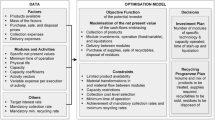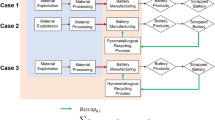Abstract
Purpose
The concept of electro mobility is gaining importance and has become more dynamic in recent years, particularly in developed economies. Besides a significant reduction of mobility-related CO2 emissions, electro mobility is also expected to minimize the current dependence on oil, while maximizing energy conversion efficiency. However, the associated shift in resource requirements towards so-called strategic metals gives reason to suspect that trade-offs could threaten the desired merits of e-mobility with regard to sustainability. This study aims to give a more comprehensive understanding of the challenges—including the issue of uncertainties—which the broad implementation of e-mobility could place on resource availability and especially on a sustainable management of special metals for the high voltage traction batteries forming the heart of the electric powertrain.
Methods
Future metal flows for three possible cathode materials containing the special metals lithium and cobalt are estimated in this paper by means of a Material Flow Analysis. Using two scenarios (dominant and pluralistic) projecting the annual demand for electric vehicles until 2050 and the free software STAN in order to perform the calculation steps to build up the model for the analysis, the MFA considers the resource input requirements based on annual vehicle registrations and the consequent energy requirements.
Results and discussion
The results indicate continuously rising lithium requirements with a wide variation in absolute terms depending on the scenario, which can be considered symptomatic for the uncertainty regarding the development of e-mobility. In the case of cobalt, the projected demand trajectories differ even more drastically between the two scenarios. In comparison to lithium though, for both scenarios cobalt requirements in absolute terms are much less than lithium requirements. With a view to currently known reserves, the cumulative demand for battery technology projected in the dominant scenario will consume 74–248 % (for two different cases) of the lithium reserves and 50 % of the cobalt reserves by 2050.
Conclusions
Despite significant differences between the examined scenarios, it becomes clear that e-mobility will be an increased driver for cobalt and particularly lithium demand in the future. Exact increases in demand for both metals are difficult to predict, especially due to the necessity of numerous assumptions, such as recycling rates, as well as data availability and quality. The results of this study imply a shift from managing primary resources, resource uses, and waste separately, towards managing materials, i.e., resource flows and their implications over the entire life cycle.








Similar content being viewed by others
Notes
Here only referring to Battery Electric Vehicles (BEV) and Plug-in Hybrid Electric Vehicles (PHEV).
As an explicit example. Note that lithium contents vary among different lithium sources.
References
Abraham D, Knuth J, Dees D, Bloom I, Christophersen J (2007) Degradation of high-power lithium-ion cells—electrochemistry of harvested electrodes. J Pow Sources 170(2):465–475
Albach S (2014) Sustainable Resource Management, Masterthesis at Carl von Ossietzky University, available online http://www.uni-oldenburg.de/cascadeuse
Allen F, Halloran P, Leith A, Clare Lindsay M (2009) Using material flow analysis for sustainable materials management. J Ind Ecol 13(5):662–665
Andersson B, Råde I (2001) Metal resource constraints for electric-vehicle batteries. Transp Res Part D: Transp Environ 6:297–324
Angerer G, Marscheider-Weidemann F, Lüllmann A, Erdmann L, Scharp M, Handke V et al. (2009a) Rohstoffe für Zukunftstechnologien. Fraunhofer Institut für System- und Innovationsforschung (ISI); Institut für Zukunftsstudien und Technologiebewertung (IZT). Stuttgart: Fraunhofer IRB Verlag
Angerer G, Marscheider-Weidemann F, Wendl M, Wietschel M (2009b) Lithium für Zukunftstechnologien - Nachfrage und Angebot unter besonderer Berücksichtigung der Elektromobilität. Fraunhofer ISI, Fraunhofer Systemforschung Elektromobilität (FSEM) & Innovationsallianz-Lithium-Ionen-Batterie (LIB2015), Karlsruhe
Bernstein L, Bosch P, Canziani O, Chen Z, Christ R, Davidson O et al (2007) Climate change 2007: synthesis report. IPCC, Valencia
Brandl M, Gall H, Wenger M, Lorentz V, Giegerich M, Baronti F et al. (2012) Batteries and battery management systems for electric vehicles. 2012 Design, Automation and Test in Europe Conf and Exhibition, pp 971–976
Broussely M, Herreyre S, Biensan P, Kasztejna P, Nechev K, Staniewicz R (2011) Aging mechanism in Li ion cells and calendar life predictions. J Pow Sources 97–98:13–21
Brunner P, Rechberger H (2004) Practical handbook of material flow analysis. Lewis Publishers, Boca Raton
Buchert M, Schüler D, Bleher D (2009) Critical metals for future sustainable technologies and their recycling potential. Öko-Institut e.V.; UNEP; United Nations University
Buchert M, Jenseit W, Dittrich S, Hacker F, Schüler-Hainsch E, Ruhland K et al. (2011) Ressourceneffizienz und ressourcenpolitische Aspekte des Systems Elektromobilität. Arbeitspaket 7 des Forschungsvorhabens OPTUM, Öko-Institut e.V.;Umicore; TU Clausthal; Daimler AG, Darmstadt
Bundesregierung D (2009) Nationaler Entwicklungsplan Elektromobilität der Bundesregierung. Germany, Berlin
Cencic O, Rechberger H (2008) Material flow analysis with software STAN. J Env Eng Manag 18(1):3–7
Dijkema G, Reuter M, Verhoef E (2000) A new paradigm in waste management. Waste Manag 20(8):633–638
Evans K (2014) Lithium. In: Gunn G (ed) Critical metals handbook, 1st edn. Wiley, Keyworth, Nottingham, UK, pp 230–260
Fulton L, Eads G (2004) IEA/SMP model documentation and reference case projection. WBCSD, WBCSD
Gaines L, Cuenca R (2000) Costs of lithium-ion batteries for vehicles. Argonne National Laboratory, Center for Transportation Research, Argonne, IL, USA
Gerssen-Gondelach S, Faaij A (2012) Performance of batteries for electric vehicles on short and longer term. J Pow Sources 212:111–129
Gruber P, Medina P, Keoleian G, Kesler SE, Wallington T (2011) Global lithium availability: a constraint for electric vehicles? J Ind Ecol 15:760–775
Hagelüken C, Meskers C (2010) Complex life cycles of precious and special metals. In: Graedel T, van der Voet E (eds) Linkages of sustainability. The MIT Press, Cambridge, pp 163–197
Hawkins TR, Singh B, Majeau-Bettez G, Hammer Stromman A (2012) Comparative environmental life cycle assessment of conventional and electric vehicles—supporting material. Retrieved March 19, 2014 from Wiley Online Library: http://onlinelibrary.wiley.com/store/10.1111/j.1530-9290.2012.00532.x/asset/supinfo/jiec532-sup-0001-S1.pdf?v=1&s=0ffcfad9015984dae69de3941a663e52dbe475f0
Hayner C, Zhao X, Kung H (2012) Materials for rechargeable lithium-ion batteries. Ann Rev Chem Biomolecu Eng 3:445–471
Huggins R (2009) Advanced batteries—material science aspects. Springer, New York
IRP (2012) Responsible resource management for a sustainable world: Findings from the International Resource Panel. United Nations Environment Programme
Jaskula B (2014, February) Mineral commodity summary: lithium. (USGS, Ed.) Retrieved May 20, 2014 from USGS: http://minerals.usgs.gov/minerals/pubs/commodity/lithium/mcs-2014-lithi.pdf
Kaiser O, Eickenbusch H, Grimm V, Zweck (2008) Zukunft des Autos. Zukünftige Technologien Consulting der VDI Technologiezentrum GmbH, Düsseldorf, Germany
Kesler S, Gruber P, Medina P, Keoleian G, Everson M, Wallington T (2012) Global lithium resources: relative importance of pegmatite, brine and other deposits. Ore Geolog Rev 48:55–69
Konietzko S, Gernuks M (2011) Ressourcenverfügbarkeit von sekundären Rohstoffen - Potenzialanalyse für Lithium und Kobalt. LiBRi; LithoRec
Kushnir D, Sandén B (2012) The time dimension and lithium resource constraints for electric vehicles. Res Pol 37(1):93–103
Majeau-Bettez G, Hawkins T, Hammer Stromman A (2011) Life cycle environmental assessment of lithium-ion and nickel metal hydride batteries for plug-in hybrid and battery electrical vehicles. Supporting information. Environ Sci Technol 45(10):4548–4553
Menzie D, Soto-Viruet Y, Bermúdez-Lugo O, Mobbs PM, Perez AA, Taib M, Wacaster S, and Staff (2013) Review of selected global mineral industries in 2011 and an outlook to 2017: U.S. Geological Survey Open-File Report 2013–1091, 33 p., http://pubs.usgs.gov/of/2013/1091, accessed June 19th, 2015
Meshram P, Pandey BD, Mankhand TR (2014) Extraction of lithium from primary and secondary sources by pre-treatment, leaching and separation. A Comprehen Rev Hydrometallurgy 150(IF-2.12):192–208
Mondal P, Kumar A, Agarval V, Sharma N, Vijay P, Bhangale U et al (2011) Critical review of trends in GHG emissions from global automotive sector. Brit J Env Climate Change 1(1):1–12
Notter D, Gauch M, Widmer R, Wäger P, Stamp A, Zah R et al (2010) Contribution of Li-ion batteries to the environmental impact of electric vehicles. Supporting information. Environ Sci Technol 44(17):6550–6556
NPE (2012) Fortschrittsbericht der Nationalen Plattform für Elektromobilität (Dritter Bericht). NPE & GGEMO. Berlin, Germany: BMVBS
OICA (2014) New PC registrations or sales 2005–2013. Retrieved April 27, 2014 from International Organization of Motor Vehicle Manufacturers: http://www.oica.net/wp-content/uploads//pc-sales-2013.pdf
Peters A, Doll C, Plötz P, Sauer A, Schade W, Thielmann A et al. (2013) Konzepte der Elektromobilität - Ihre Bedeutung für Wirtschaft, Gesellschaft und Umwelt. (B. f. (TAB), Ed.) Berlin: edition sigma
Pollet B, Staffell I, Shang J (2012) Current status of hybrid, battery and fuel cell electric vehicles: From electrochemistry to market prospects. Electroch Acta 84:235–249
Roberts S, Gunn G (2014) Cobalt. In Gunn, G (ed) Critical metals handbook, 1st edn. John Wiley & Sons, Keyworth, Nottingham, UK, pp 122–147
Scrosati B (2000) Recent advances in lithium ion battery materials. Electroch Acta 45:2461–2466
Scrosati B, Garche J (2010) Lithium batteries: status, prospects and future. J Pow Sources 195:2419–2430
Shedd K (2014) Mineral commodity summary: cobalt. Retrieved May 21, 2014 from USGS: http://minerals.usgs.gov/minerals/pubs/commodity/cobalt/mcs-2014-cobal.pdf
Stahel W (2006) The role of metals for designing products and solutions in the context of a sustainable society. In von Gleich A, Ayres R, Gößling-Reisemann S (eds) Sustainable metals management. Springer, Dordrecht, pp 593–607
Thielmann A, Isenmann R, Wietschel M (2010) Technologie-Roadmap Lithium-Ionen-Batterien 2030. Fraunhofer-Institut für System- und Innovationsforschung (ISI). Karlsruhe, Germany: Fraunhofer Verlag
Thielmann A, Sauer A, Isenmann R, Wietschel M (2012) Technologie-Roadmap Energiespeicher für die Elektromobilität. Fraunhofer-Institut für System- und Innovationsforschung, Karlsruhe, Germany
Tie S, Tan C (2013) A review of energy sources and energy management system in electric vehicles. Renew Sust Energy Rev 20:82–102
U.S. Geological Survey (2015) Mineral commodity summaries 2015: U.S. Geological Survey, 10.3133/70140094, accessed June 19th, 2015
Vikström H, Davidsson S, Höök M (2013) Lithium availability and future production outlooks. Appl Energy 110:252–266
von Gleich A (2006) Outlines of Sustainable Metals Industry. In: von Gleich A, Ayres R, Gößling-Reisemann S (eds) Sustainable metals management. Springer, Dordrecht, pp 4–40
Wagner R, Preschitschek N, Passerini S, Leker J, Winter M (2013) Current research trends and prospects among the various materials and designs used in lithium-based batteries. J Appl Electrochem 43:481–496
Winter M, Brodd R (2004) What are batteries, fuel cells, and supercapacitors? Chem Rev 104:4245–4269
Ziemann S, Mueller D, Grunwald A, Schebek L, Weil M (2014) Rohstoffverfügbarkeit für ein zukünftiges Mobilitäts- und Energiesystem - Was können Untersuchungen der Rohstoffkreisläufe beitragen? In: Teipel U, Reller A (eds) 3. Symp Rohstoffeffizienz und Rohstoffinnovationen. Stuttgart: Fraunhofer Verlag, pp 405–417
Acknowledgments
Part of the research was made possible through founding the research group “Cascade Use” at Oldenburg University, funded by the German Federal Ministry of Education and Research (No: 01LN1310A).
Compliance with Ethical Standards
ᅟ
Conflicts of interest
The author(s) declare that they have no competing interests
Author information
Authors and Affiliations
Corresponding author
Additional information
Responsible editor: Ming Chen
Rights and permissions
About this article
Cite this article
Pehlken, A., Albach, S. & Vogt, T. Is there a resource constraint related to lithium ion batteries in cars?. Int J Life Cycle Assess 22, 40–53 (2017). https://doi.org/10.1007/s11367-015-0925-4
Received:
Accepted:
Published:
Issue Date:
DOI: https://doi.org/10.1007/s11367-015-0925-4




